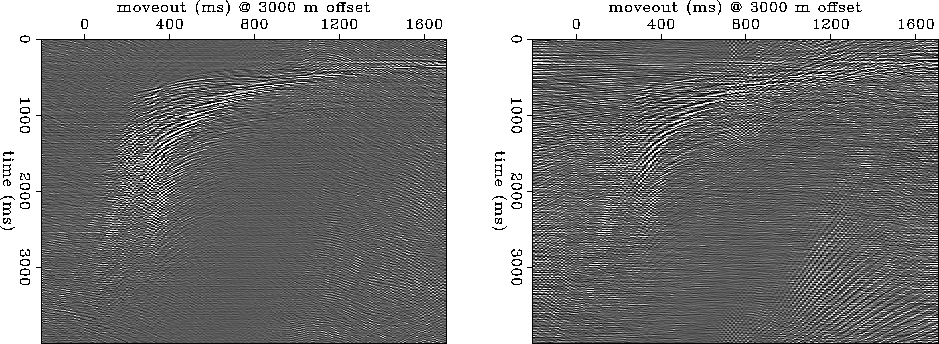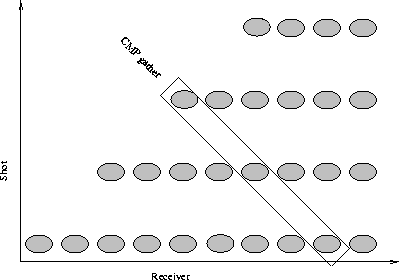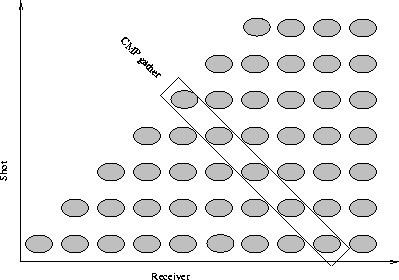 |
Figure 1 Unaliased, well-sampled data and aliased, poorly sampled data, before hyperbolic Radon transform. These gathers are Radon transformed to make the panels in Figure radExpost.
Seismic data is expensive to acquire, and spatial sampling is an important limiting factor in processing. Taken together, that means it should be easy to find examples where it is useful to make more data, without going to the expense of actually recording it. It turns out that in most 3-D marine acquisition (which includes most of the seismic data recorded in recent years), there is systematic undersampling along a couple of different axes. The inline shot axis is one that tends to be undersampled. The resulting aliasing can have a significant impact on multiple suppression in particular.
Multiple suppression is a motivating example of a multichannel process that can be severely hindered by data aliasing. Interpolating data does not, in and of itself, do anything to remove multiples, but it can significantly improve the results of various multiple suppression algorithms. Radon demultiple, for example, is affected in a fairly intuitive fashion by poor sampling in offset. Where data are aliased, a single reflection event can appear to have more than one slope. Radon demultiple algorithms (and other moveout discrimination methods) are affected because at some level they amount to dip filtering the data. An aliased multiple event will have components at the expected dip value and at various other dips as well, making it difficult to remove. Figures radExpre and radExpost show well-sampled and poorly-sampled CMP gathers, and hyperbolic Radon transforms. Figure radExpre shows a well-sampled gather and the same gather with one third the sampling in offset. Figure radExpost shows hyperbolic Radon transforms of the gathers in Figure radExpre. The horizontal axis is given as milliseconds of moveout at 3000 meters of offset, instead of slowness. The well-sampled gather transforms fairly cleanly; there is not significant energy visible in areas of the transform that do not correspond to physically reasonable times and velocities. The subsampled gather produces a transform that does have the same trend, but also has artifact energy spread over most of the transform.
 |
 |
Radon multiple suppression (and multiple suppression in general) is often used as motivation in interpolation papers, because data aliasing occurs systematically in marine acquisition. Marine acquisition commonly looks like Figure boat, where a boat tows two airgun sources and three (or more) receiver cables. The number of receiver cables can be significantly larger than three, with the number of midpoints increasing proportionately, but with the pattern of midpoints staying the same. At each shot location, one or the other of the two sources fires, and the two alternate in what we call a ``flip/flop'' mode. Shot spacing for the pair considered together is normally equal to the receiver spacing, so that for a single inline the shot spacing is double the receiver spacing. The sources are positioned in such a way that they fire into interleaved sets of midpoints. This means there is an increase in the number of crossline midpoints, which is good for lateral resolution of the subsurface, but it also means that the fold decreases. Specifically, a given midpoint only gets a trace from every second shot, so the common-midpoint (CMP) fold is cut in half and effective source and receiver spacing is doubled.
In the older single source acquisition, CMP fold was already half the number of receivers, spread over the same offset range, meaning that unaliased shot gathers could be sorted into aliased CMP gathers. This is the so-called ``sampling paradox'' Vermeer (1990). The additional halving due to the ``flip/flop'' acquisition means that the trace spacing in a common midpoint gather is four times the trace spacing in a common shot gather. Figures stackingchart1 and stackingchart2 illustrate the sampling for CMP gathers in a single inline in a ``flip/flop'' marine survey and in a survey with a single source. With a single source, shot spacing and receiver spacing are the same, and offset spacing within a CMP gather is double that. With two sources, shot spacing is twice the receiver spacing, and offset spacing within a CMP gather is quadruple the receiver spacing. Jakubowicz 1994 gives an alternate explanation in terms of spatial frequencies. Shot gathers are antialiased in the inline direction by receiver arrays in the streamer cables, but it is not surprising for seismic events to be aliased in a CMP gather.
 |
 |
 |
Other multiple removal schemes depend equally on data sampling. Seafloor-related multiples can be modeled from the recorded data by upward continuation Berryhill and Kim (1986). This process models first order multiples from primaries, second order multiples from first order multiples, and so on. The recorded data minus the modeled multiples yields the desired primaries. Upward continuation is a migration-type operator, and not surprisingly creates artifacts if the data are not well sampled. The artifacts make it harder to match the modeled multiples to the recorded data. Another method for modeling multiples from primaries is the surface related multiple elimination (SRME) method of Delft Berkhout and Verschuur (1997); Verschuur and Berkhout (1997). In this method, the recorded traces function both as input data and as a convolutional operator, both data aliasing and operator aliasing result from insufficient sampling. These two methods rely on reciprocity as well. Marine acquisition is often missing near source receivers, and sources are offset in the crossline direction from the receivers, so it is impossible to construct reciprocal gathers from the recorded data. This introduces an additional sort of missing data problem.
The crossline receiver axis is also poorly sampled, as suggested by Figure boat. The physical problems of towing something through the water make it difficult to hope for a dense crossline arrangement of receivers. Modern boats may have a dozen or more streamers, but these extra crossline receivers tend to be used to widen the aperture rather than to refine the sampling. The scarcity of crossline receiver sampling makes various kinds of potentially interesting operations difficult. True 3-D multiple suppression and 3-D full wave equation migration would both (eventually) want better crossline sampling.